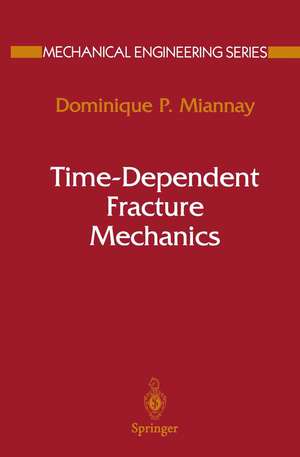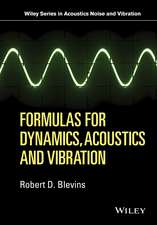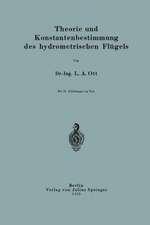Time-Dependent Fracture Mechanics: Mechanical Engineering Series
Autor Dominique P. Miannayen Limba Engleză Paperback – 21 oct 2012
Din seria Mechanical Engineering Series
-
 Preț: 391.84 lei
Preț: 391.84 lei - 18%
 Preț: 1110.72 lei
Preț: 1110.72 lei - 15%
 Preț: 593.73 lei
Preț: 593.73 lei - 18%
 Preț: 944.99 lei
Preț: 944.99 lei - 15%
 Preț: 653.14 lei
Preț: 653.14 lei - 17%
 Preț: 363.12 lei
Preț: 363.12 lei - 18%
 Preț: 1239.05 lei
Preț: 1239.05 lei - 15%
 Preț: 640.06 lei
Preț: 640.06 lei - 18%
 Preț: 1129.65 lei
Preț: 1129.65 lei - 15%
 Preț: 522.24 lei
Preț: 522.24 lei - 15%
 Preț: 654.77 lei
Preț: 654.77 lei - 15%
 Preț: 643.34 lei
Preț: 643.34 lei - 15%
 Preț: 611.40 lei
Preț: 611.40 lei - 18%
 Preț: 765.96 lei
Preț: 765.96 lei - 20%
 Preț: 631.70 lei
Preț: 631.70 lei - 18%
 Preț: 1009.22 lei
Preț: 1009.22 lei -
 Preț: 418.34 lei
Preț: 418.34 lei - 15%
 Preț: 640.71 lei
Preț: 640.71 lei -
 Preț: 403.53 lei
Preț: 403.53 lei - 18%
 Preț: 813.97 lei
Preț: 813.97 lei - 18%
 Preț: 1386.48 lei
Preț: 1386.48 lei - 18%
 Preț: 951.47 lei
Preț: 951.47 lei - 18%
 Preț: 833.09 lei
Preț: 833.09 lei - 18%
 Preț: 936.60 lei
Preț: 936.60 lei - 15%
 Preț: 644.49 lei
Preț: 644.49 lei - 18%
 Preț: 941.05 lei
Preț: 941.05 lei - 18%
 Preț: 1386.17 lei
Preț: 1386.17 lei -
 Preț: 399.67 lei
Preț: 399.67 lei - 18%
 Preț: 1389.44 lei
Preț: 1389.44 lei - 18%
 Preț: 790.46 lei
Preț: 790.46 lei - 18%
 Preț: 1388.22 lei
Preț: 1388.22 lei - 18%
 Preț: 1024.53 lei
Preț: 1024.53 lei - 15%
 Preț: 590.16 lei
Preț: 590.16 lei - 18%
 Preț: 1234.00 lei
Preț: 1234.00 lei - 18%
 Preț: 1386.62 lei
Preț: 1386.62 lei - 15%
 Preț: 543.85 lei
Preț: 543.85 lei -
 Preț: 391.61 lei
Preț: 391.61 lei - 18%
 Preț: 944.19 lei
Preț: 944.19 lei - 18%
 Preț: 736.16 lei
Preț: 736.16 lei - 18%
 Preț: 943.88 lei
Preț: 943.88 lei - 15%
 Preț: 693.21 lei
Preț: 693.21 lei - 18%
 Preț: 781.77 lei
Preț: 781.77 lei - 15%
 Preț: 639.08 lei
Preț: 639.08 lei - 23%
 Preț: 737.28 lei
Preț: 737.28 lei - 15%
 Preț: 641.53 lei
Preț: 641.53 lei -
 Preț: 401.42 lei
Preț: 401.42 lei
Preț: 399.12 lei
Nou
Puncte Express: 599
Preț estimativ în valută:
76.37€ • 79.95$ • 63.19£
76.37€ • 79.95$ • 63.19£
Carte tipărită la comandă
Livrare economică 05-19 aprilie
Preluare comenzi: 021 569.72.76
Specificații
ISBN-13: 9781461265375
ISBN-10: 1461265371
Pagini: 488
Ilustrații: XXVI, 459 p.
Dimensiuni: 155 x 235 x 26 mm
Greutate: 0.68 kg
Ediția:Softcover reprint of the original 1st ed. 2001
Editura: Springer
Colecția Springer
Seria Mechanical Engineering Series
Locul publicării:New York, NY, United States
ISBN-10: 1461265371
Pagini: 488
Ilustrații: XXVI, 459 p.
Dimensiuni: 155 x 235 x 26 mm
Greutate: 0.68 kg
Ediția:Softcover reprint of the original 1st ed. 2001
Editura: Springer
Colecția Springer
Seria Mechanical Engineering Series
Locul publicării:New York, NY, United States
Public țintă
ResearchCuprins
1. Structural-Integrity Assessment: The Relevant Fracture-Toughness Evaluation.- 1.1 The Energy Approach: The Ductile-to-Brittle Transition (DBT) and the Fracture Analysis Diagram (FAD).- 1.2 Low-Toughness Materials.- 1.3 Determination of Dynamic Fracture Toughness by Instrumented Pre-Cracked Charpy Impact Testing.- 1.4 The Ductile to Brittle Transition and Fracture Toughness.- 1.5 Measurement of Flow and Fracture Behaviors Using Miniature-Scale and Compound Specimens.- Appendix I: The Constraint Issue.- Appendix II: Warm Pre-Stressing Effect.- Appenidix III: Choice of Steel Qualities with Regard to the Risk of Brittle Fracture.- 2. Structural Integrity Assessment: The Relevant Loading Evaluation.- 2.1 Procedures for Pure Mechanical Loading at Low Temperature.- 2.2 Procedures for Combined Loading.- 2.3 Safety Margins.- 2.4 Assessment Methods at High Temperature.- Appendix I: Probabilistic Integrity Analysis of Mechanical Components.- 3. Dynamic Fracture: Elementary Dynamics and Microscopic Fracture.- 3.1 Dynamic Behavior of a Material.- 3.2 Fracture Micromechanisms.- 4. Dynamic Fracture: The St Ationary Crack.- 4.1 Linear Elastic Analysis of the Two—Dimensional Crack.- 4.2 Crack Speed and Thermal-Field Measurements.- 4.3 Testing Methods and Fracture Criteria in Mode 1.- 4.4 Main Results on Toughness.- 4.5 Local Approach to Fracture and Continuum Damage Mechanics.- 4.6 Testing Methods and Fracture Criteria in Mode II.- 4.7 Mixed-Mode Dynamic Crack Initiation.- 5. Dynamic Fracture: The Moving Crack.- 5.1 Linear Elastic Modeling of Crack Growth.- 5.2 Elastic-Plastic Modeling ofCrack Growth.- 5.3 Mechanistic Models of Crack Growth.- 6. Creep Fracture: Creep Laws And Elementary Microscopic Fracture Models.- 6.1 Creep Flow Behavior.- 6.2 Mechanistic-Creep Failure Analysis.-6.3 Fracture Parameters.- 6.4 Continuum-Damage Mechanics.- Appendix I.- Appendix II.- Appendix III.- 7. Creep Fracture Mechanics.- 7.l The Stationary Crack.- 7.2 The Moving Crack.- 7.3. Relationship Between Micromechanisms and Macromechanics.- 7.4. Recommended Practice for Determining Creep-Crack Growth in a Material.- 7.5. The Stationary Crack Under Mixed-Mode Loading.- 8. Fatigue and Creep-Fatigue.- 8.1 Fatigue, Creep, and Creep-Fatigue Damage.- 8.2 Fatigue, Creep, and Creep-Fatigue Crack Propagation.- Guide for Further Reading and Bibliography.- Answers to Selected Exercises.
Recenzii
From the reviews of the first edition:
"Intended for engineers, researchers, and graduate students dealing with materials science, structural design, and non-destructive testing and evaluation, ‘Time-Dependent Fracture Mechanics’ by D. Miannay represents a continuation of the author’s book ‘Fracture Mechanics’ from 1997. The discussion of design codes and procedures will be of use to practicing engineers … the extensive bibliography and discussion of recent results will make it a useful reference for academic researchers; and graduate students will find clear explanations and worked examples." (Materialprüfung, Vol. 44 (5), 2002)
"The book is devoted to the failure of cracked bodies, and its content is divided into three main logical parts. … On the whole, the monograph could be recommended as reference book to postgraduate students, scientists and engineers working in the field of structural design, nondestructive evaluation and safety assessment." (Ján Sládek, Zentralblatt MATH, Vol. 977, 2002)
"Intended for engineers, researchers, and graduate students dealing with materials science, structural design, and non-destructive testing and evaluation, ‘Time-Dependent Fracture Mechanics’ by D. Miannay represents a continuation of the author’s book ‘Fracture Mechanics’ from 1997. The discussion of design codes and procedures will be of use to practicing engineers … the extensive bibliography and discussion of recent results will make it a useful reference for academic researchers; and graduate students will find clear explanations and worked examples." (Materialprüfung, Vol. 44 (5), 2002)
"The book is devoted to the failure of cracked bodies, and its content is divided into three main logical parts. … On the whole, the monograph could be recommended as reference book to postgraduate students, scientists and engineers working in the field of structural design, nondestructive evaluation and safety assessment." (Ján Sládek, Zentralblatt MATH, Vol. 977, 2002)
















